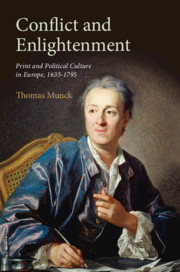Book contents
- Conflict and Enlightenment
- Conflict and Enlightenment
- Copyright page
- Contents
- Figures
- Acknowledgements
- Introduction
- 1 Print, Production, Authors and Readers
- 2 Instability and Politicisation (1630–77)
- 3 Subversive Print in the Early Enlightenment
- 4 Translation and Transmission across Cultural Borders
- 5 High Enlightenment, Political Texts and Reform 1748–89
- 6 Revolution: Democracy and Loyalism in Print 1789–95
- Conclusions
- Select Bibliography (Works Published after 1800)
- Index
6 - Revolution: Democracy and Loyalism in Print 1789–95
Published online by Cambridge University Press: 21 October 2019
- Conflict and Enlightenment
- Conflict and Enlightenment
- Copyright page
- Contents
- Figures
- Acknowledgements
- Introduction
- 1 Print, Production, Authors and Readers
- 2 Instability and Politicisation (1630–77)
- 3 Subversive Print in the Early Enlightenment
- 4 Translation and Transmission across Cultural Borders
- 5 High Enlightenment, Political Texts and Reform 1748–89
- 6 Revolution: Democracy and Loyalism in Print 1789–95
- Conclusions
- Select Bibliography (Works Published after 1800)
- Index
Summary
The technical aspects of printing and distribution remained largely unchanged in the 1790s, but censorship controls and copyright became more complex and unpredictable. The failure of political leadership in France naturally encouraged extensive discussion throughout the rest of Europe, with a wide-ranging exploration in print of an array of political themes: the nature of civil government, national identity, democracy, popular political participation, voting, formal constitutions, law reform, and other contentious issues. Women saw unprecedented opportunities in Paris, but their efforts to gain political influence were largely thwarted. Strong popular political participation exposed deep ambiguities which were reflected in print. A comparison of political debate in London and Paris with other parts of Europe suggests that authors, publishers and readers all suffered restrictions, but such factors were both asynchronous across different cities and closely contingent on local political circumstances. Disagreements over the need for repressive control of print were not resolved in the 1790s.
- Type
- Chapter
- Information
- Conflict and EnlightenmentPrint and Political Culture in Europe, 1635–1795, pp. 284 - 335Publisher: Cambridge University PressPrint publication year: 2019

